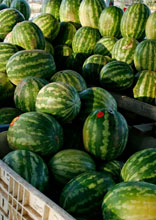How do you choose a quality Watermelon?
How do you choose a quality Watermelon?
We all rush to buy watermelons as soon as the season permits, but the question is – how do we know which to choose? A variety of tips from the Ministry of Agriculture and Farming Development.
The watermelon must have a shiny surface. A dull, faded colour testifies to prolonged storage, which in most cases damages the quality of the fruit.
How many discoloured patches appear on the watermelon? Every watermelon sports one large patch, located in the area where the fruit touches the ground. If you identify more areas that are discoloured or dull in comparison to the rest of the fruit, know that this is a watermelon that has been over-exposed to the sun, diminishing its quality.
Look at the stalk of the watermelon – a green, fresh stalk bears witness to a fresh watermelon. The drier the stalk, the older the fruit must be, having been picked a while ago already.
Hum onto the watermelon and try to feel how pliable it is. Choose the most solid and sturdy fruit – a softer watermelon indicates prolonged storage that considerably lessens its quality.
How should a good watermelon appear to the discerning eye? Look out for a symmetrical rounded or oval shape. This sort of structure indicates that the fruit developed properly and assures you that there won’t be hollows inside the flesh of the fruit - although hollows such as these are typically found in watermelons picked between March and April, the beginning of the watermelon season.
Can the humble watermelon also be a musical instrument? The legendary tapping on the surface of the fruit has become so widespread that people tap the fruit without knowing what it is they are supposed to hear. Shimshon Omer, expert on watermelon production at the Department of Agriculture, explains: “When we tap on a watermelon, we have to wait until we hear an answering tone. The watermelon must ‘respond’ in the form of a clear sound. In a case where you don’t hear a resounding echo to your tapping, the watermelon is overripe and its texture and taste will be sub-standard.”
After this careful preliminary check, and after you have lugged the watermelon home, how do you care for it so as to preserve its freshness and quality until it is served? Shimshon Omer advises that you can store the fruit in the refrigerator for up to a week. If possible, the watermelon should stay whole even while in the fridge, otherwise it can be sliced in half and wrapped in cling-wrap.
Before serving, the watermelon must be washed thoroughly even though the peel is not eaten, and sliced using a large, sharp and sturdy knife. Any remains should be wrapped once again in cling-wrap and returned to the refrigerator as soon as possible.
Bon Appetite!
The consumption of watermelon guarantees not only a refreshing treat, but also the intake of a rich variety of nutritional elements. According to experts in the Department of Agriculture, eating a slice of watermelon a day contributes a high level of beneficial nutrients to your diet. The watermelon is rich in potassium, contains vitamin C, and various other components that are known in particular to protect against inflammation of the prostate.
In Israel 160,000 tons of watermelons are grown each year, over an area of 27,000 dunam. For the most part, these watermelons are reserved for the local market and considered the favorite summer fruit of Israelis. The main varieties that are grown in Israel are the seedless type, and are categorized according to their size: Regular (7 – 10 kilos), medium (3 – 5 kilos), and small (1.5 – 3 kilos). Watermelons that weigh over 10 kilos are usually found to be of lesser quality.
Watermelons are grown in Israel between the months of April and August, but if you look carefully you may find watermelons also in the months of February, March, September and October. At the start of the watermelon season the produce comes from an area known as Arava, and afterwards from the north of the Dead Sea, Emek Beit Sh’an and the western Negev. Towards the end of the season, you will find watermelons from Afula, the western Galil, the Negev and the center of the country.







